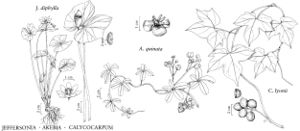Difference between revisions of "Lardizabalaceae"
FNA>Volume Importer |
imported>Volume Importer |
||
| (7 intermediate revisions by 2 users not shown) | |||
| Line 13: | Line 13: | ||
}}<!-- | }}<!-- | ||
| − | --><span class="statement" id="st- | + | --><span class="statement" id="st-undefined" data-properties=""><b>Vines </b>[small trees or shrubs], woody, evergreen or deciduous. <b>Stems</b> without spines. <b>Leaves</b> alternate; stipules absent [except in Lardizabala]; petioles present. <b>Leaf</b> blade palmately compound [pinnately compound or 1-3-ternate]. <b>Inflorescences</b> axillary, racemes, occasionally solitary flowers, flowers pedicellate. <b>Flowers</b> unisexual, staminate and pistillate on same plants in same or different inflorescences [staminate and pistillate on different plants or flowers bisexual, staminate, and pistillate], showy, 3-merous; sepaloid bracteoles absent; sepals 3-6, distinct, usually petaloid, not spurred; petals absent [6; nectary present]. <b>Staminate</b> flowers: stamens 6(-8), distinct [proximally connate]; anthers with 2 pollen sacs, extrorse, dehiscing longitudinally; pistillodes sometimes present. <b>Pistillate</b> flowers: staminodes sometimes present; pistils 3-15 in 1-5 whorls of 3 each, 1-carpellate, 1-locular; placentation submarginal or laminar; ovules 100-several hundred [1-20]; stigma 1, sessile to nearly sessile. <b>Fruits</b> aggregates of berries or of fleshy follicles (sometimes only 1 pistil maturing). <b>Seeds</b> [1-]100-several hundred, never stalked; aril absent; endosperm abundant; embryo small, straight.</span><!-- |
-->{{Treatment/Body | -->{{Treatment/Body | ||
| − | |distribution=North America;South America;Asia | + | |distribution=North America;South America;Asia. |
|discussion=<p>Genera ca. 8, species ca. 30 (1 genus, 1 species in the flora).</p><!-- | |discussion=<p>Genera ca. 8, species ca. 30 (1 genus, 1 species in the flora).</p><!-- | ||
--><p>Lardizabalaceae have a disjunct distribution. Two of the genera–Decaisnea and Lardizabala–are found in Chile; the others are Asiatic (Himalayas to Vietnam, Japan, and Korea).</p> | --><p>Lardizabalaceae have a disjunct distribution. Two of the genera–Decaisnea and Lardizabala–are found in Chile; the others are Asiatic (Himalayas to Vietnam, Japan, and Korea).</p> | ||
| Line 39: | Line 39: | ||
-->{{#Taxon: | -->{{#Taxon: | ||
name=Lardizabalaceae | name=Lardizabalaceae | ||
| − | |author=John W. Thieret; John T. Kartesz | + | |author=John W. Thieret;John T. Kartesz |
|authority=Decaisne | |authority=Decaisne | ||
|rank=family | |rank=family | ||
| Line 47: | Line 47: | ||
|family=Lardizabalaceae | |family=Lardizabalaceae | ||
|illustrator=John Myers | |illustrator=John Myers | ||
| − | |distribution=North America;South America;Asia | + | |illustration copyright=Flora of North America Association |
| + | |distribution=North America;South America;Asia. | ||
|reference=ernst1964a;matthews1989a;prantl1888a;spongberg1979a | |reference=ernst1964a;matthews1989a;prantl1888a;spongberg1979a | ||
|publication title= | |publication title= | ||
|publication year= | |publication year= | ||
|special status= | |special status= | ||
| − | |source xml=https:// | + | |source xml=https://bitbucket.org/aafc-mbb/fna-data-curation/src/2e0870ddd59836b60bcf96646a41e87ea5a5943a/coarse_grained_fna_xml/V3/V3_795.xml |
| − | |||
| − | |||
| − | |||
| − | |||
| − | |||
| − | |||
| − | |||
| − | |||
| − | |||
| − | |||
| − | |||
| − | |||
| − | |||
| − | |||
| − | |||
| − | |||
| − | |||
| − | |||
| − | |||
| − | |||
| − | |||
| − | |||
| − | |||
| − | |||
| − | |||
| − | |||
| − | |||
| − | |||
| − | |||
| − | |||
| − | |||
| − | |||
| − | |||
| − | |||
| − | |||
| − | |||
| − | |||
| − | |||
| − | |||
| − | |||
| − | |||
| − | |||
}}<!-- | }}<!-- | ||
-->[[Category:Treatment]] | -->[[Category:Treatment]] | ||
Latest revision as of 21:51, 5 November 2020
Vines [small trees or shrubs], woody, evergreen or deciduous. Stems without spines. Leaves alternate; stipules absent [except in Lardizabala]; petioles present. Leaf blade palmately compound [pinnately compound or 1-3-ternate]. Inflorescences axillary, racemes, occasionally solitary flowers, flowers pedicellate. Flowers unisexual, staminate and pistillate on same plants in same or different inflorescences [staminate and pistillate on different plants or flowers bisexual, staminate, and pistillate], showy, 3-merous; sepaloid bracteoles absent; sepals 3-6, distinct, usually petaloid, not spurred; petals absent [6; nectary present]. Staminate flowers: stamens 6(-8), distinct [proximally connate]; anthers with 2 pollen sacs, extrorse, dehiscing longitudinally; pistillodes sometimes present. Pistillate flowers: staminodes sometimes present; pistils 3-15 in 1-5 whorls of 3 each, 1-carpellate, 1-locular; placentation submarginal or laminar; ovules 100-several hundred [1-20]; stigma 1, sessile to nearly sessile. Fruits aggregates of berries or of fleshy follicles (sometimes only 1 pistil maturing). Seeds [1-]100-several hundred, never stalked; aril absent; endosperm abundant; embryo small, straight.
Distribution
North America, South America, Asia.
Discussion
Genera ca. 8, species ca. 30 (1 genus, 1 species in the flora).
Lardizabalaceae have a disjunct distribution. Two of the genera–Decaisnea and Lardizabala–are found in Chile; the others are Asiatic (Himalayas to Vietnam, Japan, and Korea).
